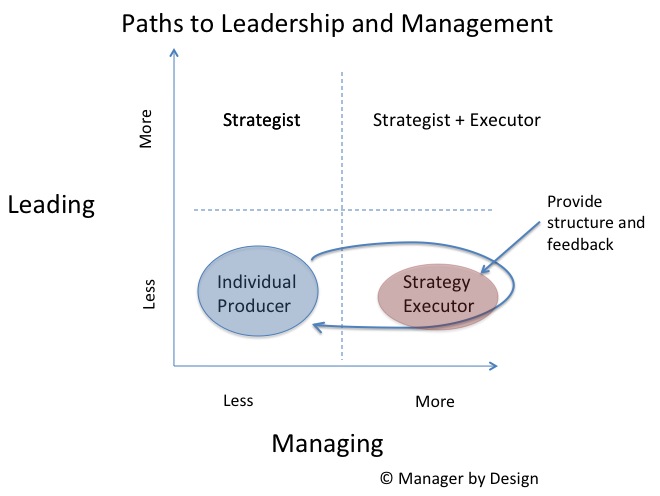Management Design: A proposed design so that new managers embrace learning management skills
In my previous article, I discussed how an improved design would be to have structure and feedback provided to those who take on a leadership/strategy role, however temporary. This way, they learn strategy while doing strategy. Seems simple enough, but how often is it done?
Now let’s transition the discussion away from leaders and to managers. In the Manager by Designsm leadership and management model, we can see how managers can learn their role using structure and feedback, and that it is possible to loop into the role and back out of it:
If someone goes into a team management role, they reason they have done this is to assure some sort of strategy execution. Sounds pretty important! So this sounds like a design requirement – makes sure someone is good at strategy execution.
Yet, as I have documented in this blog on occasion, there is limited amount of emphasis that managers in obtaining and receiving feedback on how they perform their job as managers. This is ironic, since a core element of a manager’s job is to provide that feedback to the individual producers.
I see this as a design issue: When managers get into the role of managing, they are thus “in charge”. Under this paradigm, if the manager appears to not be in charge in any way, then they are not performing their job. So all appearances have to be on not appearing vulnerable and appearing solely authoritative. So once someone becomes a manager, they are simultaneously resistant to learning their job as manager (an act of vulnerability) while performing their job as manager. The paradigm is bad design, since the manager is on his or her own in determining what the management practices are, and whatever practices are chosen, they are the correct practices from the manager’s perspective.
Under the management design I propose, it is important to infuse learning how to manage in the process of managing.
If you put someone in charge of a team, you want to make sure they do a good job at it. There are ways to make sure this happens.
1. Provide structure and feedback
Once someone becomes a manager, there needs to structured expectations of what a manager does. And feedback needs to be provided.
2. Return to the world of individual producer
A second paradigm that needs reconsideration is that once someone becomes a manager, they are permanently a manager. If this is not as much of a paradigm, then people will be willing to learn the “ways of managing” without fearing that they lose their expertise, sense of worth, and general productivity. They also understand that managing is something to be learned, rather than the new role where total expertise is already assumed.
The benefit is that the person “learns the management craft” like they learn other jobs, and that they are not wedded to the craft permanently. A second benefit is that they are available as managers for future organizational needs, temporary or otherwise. A third benefit is that the person who has learned the management “craft” can see when it is done well or poorly, and can help provide that feedback for future managers in the organization. A fourth benefit is that management practices and expectations are regularly infused into the organization not just with the managers.
This is a different “design” from the current common design of promoting someone to manager and hoping for great performance. Consider this as an example of an alternate management design and the ways to “design-in” better performance from managers.
Related articles:
Tenets of Management Design: Focus on the basics, then move to style points
Tenets of Management Design: Managing is a functional skill
A model to show the difference between managing and leading
Management Design: The designs we have now – Manager knows and supports only one possible strategy
Management Design: The Designs we have now: Part time strategist, part time manager
Current management design: The one with the ideas becomes the manager
Management Design: The Designs we have now: The paths to management and leadership
Management Design: An alternative path to management and leadership: Loop in and out
Management Design: Structure and Feedback in a focused area of leadership
